Your RV propane regulator guarantees the safety of your rig’s entire propane system. If your regulator breaks or malfunctions, you’ll need to replace it as soon as possible to keep your RV (and everyone inside of it) safe.
Some RV owners choose to bypass the propane regulator in their RV’s system.
But this questionable decision can lead to increased gas pressures that can be incredibly unsafe for everyone in or around your RV.
Additionally, the lack of a propane tank regulator can be inefficient. Certain RV appliances may consume more propane than they would otherwise.
And this will cause you to spend more of your hard-earned money on refilling your propane tank more often than you should.
In the worst-case scenario, propane over-consumption can lead to you having an empty tank at a moment when you really need propane just to keep your RV warm overnight.
So there are clearly plenty of reasons to choose one of the best propane regulators for RV if you need to replace or upgrade yours.
The problem is that it can be confusing to make sure you find a propane regulator that’s compatible with your RV’s propane system.
Luckily, you’ve come to the right place to learn how to determine a regulator’s compatibility and we’ll also provide in-depth reviews of the best RV propane regulator models on the market today.
Let’s get started!
What Is The Best RV Propane Regulator?
We’ve canvassed the online marketplace to bring you numerous selection for the best RV propane regulator.
If you pay close attention to what we liked and didn’t like about each of these regulators, you’ll be able to start identifying models that check as many of your boxes as possible.
Here are 6 of the best RV Propane tank Regulators on the market right now.
1. Best Overall Propane Regulator: Fairview RV Camper LP Propane 2 Stage Automatic Regulator
Our choice for the best overall RV propane regulator is the Fairview RV Camper 2-Stage Automatic Regulator because it’s an affordable and highly functional option.
The name of the game with these regulators is that they work, and this model comes with some of the best user reviews on the market.
This dual tank RV propane regulator has a whopping capacity of 262,500 BTUs per hour and it’s a two-stage regulator.
That means you can attach two separate propane tanks to it and it will automatically switch from the first tank to the second when the first is empty.
This regulator comes set at a standard propane low pressure with an eleven inch water column.
It unfortunately doesn’t come with mounting screws and the mounting holes do not come pre-tapped.
So this means you’ll need self-tapping screws to complete the installation of this regulator.
In addition, it does come with two 15-inch QCC Acme pigtails with appropriate fittings for ¼” inverted flare attachments.
The flexibility of these pigtails allows you to attach it to propane tanks that are secured vertically in your RV, travel trailer, or 5th wheel.
Things We Like
Things We Don’t Like
2. Best With Regulator Cover: Flame King Two-Stage RV Propane Regulator with Automatic Changeover
If you are looking for a propane regulator that comes with its own cover, look no further than the Flame King KT12ACR6 2-Stage Auto Changeover Regulator.
While you may not think a regulator cover is a big deal, it will go a long way towards keeping dirt, dust, and other debris from damaging the regulator itself.
This regulator is also ideal for RVs with dual propane tanks and it’s best suited for setups in which those tanks are installed vertically.
The rv propane tank regulator itself can mount easily on your RV’s propane rack and it comes with two 12-inch pigtails for connecting two propane tanks.
The automatic changeover feature of this regulator means that it will automatically pull propane from your second tank once it detects that your first tank is empty.
This feature also makes it easy to remove your first tank and refill it before both of your tanks are completely empty.
The Flame King regulator is also rated for a maximum capacity of 190,000 BTUs and the inlets are ¼” SAE inverted flare.
The outlet is ⅜” NPT female pipe thread. This regulator can also be paired with Flame King’s 48-inch Thermo Plastic hose if you want to connect it to a larger external propane tank.
Things We Like
Things We Don’t Like
3. Best For 2 Propane Tank: Camco Double-Stage Auto Change Propane Regulator For RV
If maximizing the capacity of your new RV propane regulator is your highest priority, we’d recommend the Camco Double-Stage Auto Changeover Regulator because it has the highest BTU rating on our list (aside from our choice for the Best Overall RV Propane Regulator!).
The capacity of this 2 tank propane regulator is rated up to 210,000 BTUs per hour for the primary tank. It’s also rated up to 130,000 BTUs for your reserve propane cylinder.
This regulator is best suited to RVs or travel trailers with dual propane tanks that are secured vertically.
The auto changeover feature of this regulator means that it will switch to the propane in your reserve cylinder when your primary cylinder is empty.
You won’t have to do anything to make this changeover happen, but you will be able to remove and refill your primary cylinder without interrupting the flow of propane to your rig.
While it doesn’t come with its own pigtails like some of the models on our list, it does boast ¼” SAE inverted flare inlets and a ⅜” NPT female pipe thread outlet.
These inlets and outlet are pretty standard fittings for RVs with dual propane tanks installed vertically, which means you shouldn’t need any adapters to make this regulator operational.
Things We Like
Things We Don’t Like
4. Best Budget Propane Regulator: Mr. Heater Two Stage Horizontal Vent RV Propane Regulator
Those of you looking to replace your rig’s propane regulator without overspending should check out the Mr. Heater Horizontal Vent Two-Stage Regulator.
And this selection is also the first model on our list that is designed for RVs, travel trailers, and 5th wheels with a single, horizontally-secured propane tank.
This regulator is rated for a maximum gas flow of 200,000 BTUs per hour and it has a ⅜” female pipe thread outlet and a ¼” female pipe thread inlet, which are pretty standard amongst regulators and RV propane systems.
It’s made to be installed between the permanently mounted propane tank in larger RVs and the propane line that connects to that tank.
Most RVs should have this regulator as a standard feature, but this is an ideal replacement if yours has become compromised.
It does have a left-hand thread on the end that attaches to your propane tank’s nozzle, so make sure you thread it carefully during the installation process.
And it’s a two-stage regulator that’s ideally suited for standard P.O.L. tank connections.
Things We Like
Things We Don’t Like
5. Best With Easy Indicator Light: Marshall Excelsior Auto Vert Bulk Propane Regulator
If you’d like your new camper propane regulator to feature an easy indicator light that tells you when it’s time to refill your tanks, you’ll love the Marshall Excelsior MEGR-253 2-Stage Auto Vert Bulk Regulator.
This model is designed for RVs with vertical propane tanks and it can automatically change the flow from a primary to a reserve propane cylinder with the primary tank registers empty.
It also allows you to remove and refill that primary tank without interrupting propane flow to your RV, travel trailer, or 5th wheel.
As a two-stage regulator, it can provide gas flow and higher and more consistent pressures than single-stage regulators.
It’s rated to provide a maximum gas flow of 225,000 BTUs per hour for your primary propane tank and up to 150,000 BTUs per hour for your reserve cylinder.
This regulator also boasts an easy indicator light that’s located on the top of the regulator body.
This light will remain green until your primary cylinder is empty. It will then switch to red to signal to you that it’s time to remove and refill your primary propane tank.
Things We Like
Things We Don’t Like
6. Best For External Propane Tanks: GASPRO 10FT Hose with Standard P.O.L. Propane Regulator
If you’re a full-time RVer looking for a propane regulator that will allow you to hook up an external propane tank to your rig, the GASPRO 10FT Two-Stage Regulator is the obvious choice because of its extended length and compatibility with standard P.O.L. propane tank connections.
This is also an ideal regulator if you’re going to be keeping your RV parked in once place for a full winter because you’ll be able to purchase a much larger external propane tank and have it automatically refilled by a propane service in your area.
This is what I did throughout my last full-time RV winter and it was a game-changer.
The hose on this regulator extends up to 10 feet so that you can place your external propane tank in your desired location to the front or side of your rig.
It has a maximum flow capacity rating of 190.000 BTUs per hour and it features 100% high-quality brass fittings for more sealed and secure connections.
This is also a two-stage regulator, which makes it capable of providing more consistent inlet pressure between the first and second stages.
This guarantees higher and more consistent gas flow pressures than a single-stage regulator.
Things We Like
Things We Don’t Like
What To Look For When Buying An RV Propane Regulator?
Now that you have a number of regulator options at your disposal, it’s time to learn how to compare and contrast them.
So let’s get into the most important features and specifications of propane regulators and what they mean to their performance.
RV Propane Regulator Types
When it comes to these propane regulators, there are three main types you’ll need to choose from.
So let’s start by defining each of these types and providing a few pros and cons for each type.
Single-Stage RV Propane Regulator
The good news is that you can pretty much eliminate single-stage regulators because most RVs, travel trailers, or 5th wheels can’t use them.
But you should still be aware of them because you’ll want to avoid these regulators in your search.
Single-stage regulators are more typically for barbecue grills or small camping stoves.
Trying to use one for RV use will result in a very erratic and unpredictable gas flow that can be hazardous to your health and the health of your RV.
Two-Stage Propane Regulator For RV
Two-stage regulators are much more common for RV use, but they are best suited for larger RVs.
Their two stages help to deliver more consistent gas flow and also allows for gas flow at higher pressures.
This allows them to deliver propane safely to water heaters, furnaces, stoves, ovens, and other RV appliances.
But they are more common to larger rigs with a single, onboard propane tank with a horizontal nozzle.
Automatic Dual Tank RV Propane Regulators
Automatic dual tank regulators are more commonly used for travel trailers and 5th wheels with dual propane tanks secured vertically somewhere on the rig.
These are usually smaller tanks and these regulators are designed to automatically switch from one tank to the other when the first is empty.
So if you have an RV, travel trailer, or 5th wheel with multiple tanks, you’ll need an automatic dual tank regulator.
This will also allow you to remove and refill one propane tank while the regulator still provides consistent gas flow to the essential appliances in your RV.
Construction Quality
While some of these camper propane regulators can last up to 15 years, they still need to be replaced eventually.
But if you find a regulator with a higher construction quality than most, you’ll be able to rest easy while it does its job for the next decade-plus before you have to worry about it again.
The most common materials used in the construction of RV propane regulators are raw zinc, stainless steel, aluminum, and brass.
When it comes to the fittings on a propane regulator, we’d recommend looking for something with brass fittings because they last longer and provide more sealed secure connections.
And while regulators with aluminum bodies tend to be more affordable than their stainless steel counterparts, they are nowhere near as durable. You can generally trust a regulator with stainless steel body construction.
That being said, one of the best ways to assess the construction quality of an RV propane regulator is to read through user reviews on multiple camping equipment retailers’ websites, such as Camping World, Wal-Mart, and even Amazon.
These user reviews can give you a lot of personal information about the actual performance and longevity of a regulator.
But you should always be sure to consult multiple reviews and look for overarching themes rather than taking a single user at their word.
Additionally, be wary of cheap propane regulators that make a big deal about their “heavy-duty” construction.
Because these regulators are designed to be used outside or in the exposed undercarriage of an RV, they should all be capable of handling those environments.
As such, models that make a big deal about being “weatherproof” or “heavy-duty” are wasting time advertising features that all RV propane regulators should include.
So your time is better spent making sure the regulator is compatible with your RV’s propane installation and provides sufficient capacity to provide ample gas flow to all of your appliances.
Regulator Capacity (BTU Rating)
A propane regulator’s capacity is measured by its BTU rating. BTU stands for British Thermal Units, which is a measurement of how much energy it takes to increase the temperature of one pound of water by one degree Fahrenheit.
While that might sound confusing upfront because we’re talking about gas here (not water), you should know that BTUs are the standard unit used to define the capacity of many of your gas-based RV appliances.
And, in the case of propane regulators, a higher BTU rating typically corresponds to a higher capacity.
But what BTU rating is really necessary to make a propane regulator of supplying ample gas flow to your RV?
For starters, we’d recommend looking for a regulator with a minimum rating of 100,000 BTUs per hour. But you’ll probably find that many of our choices for the best RV propane regulator have a much higher rating than that. If you have a larger RV with multiple appliances that require propane, you’ll need a regulator with a higher BTU rating.
That means that smaller RVs or travel trailers with fewer propane-reliant appliances may not require a regulator with a super high BTU rating.
That being said, the best way to ensure that the BTU rating on your new regulator matches the requirements of your RV is to check your rig’s owner’s manual.
This manual should contain the information you need regarding the minimum and maximum BTU ratings recommended for your rig’s propane system.
And if you can’t find that information there, don’t hesitate to contact your RV manufacturer directly.
Ease of Installation
The installation of your new RV propane regulator will really depend on whether the propane tanks in your rig are secured horizontally or vertically.
Many RVs come with onboard propane tanks that are horizontally secured. These tanks are usually accessed through a storage compartment door on one side of your rig or the other.
RVs with horizontal tanks are usually made to be refilled directly at a gas station that offers propane refills.
As a result, they typically don’t require an automatic changeover feature and the regulator itself can simply be installed between the tank nozzle and the propane hose.
So you’ll just need to make sure that the thread and the size of the fittings on your new regulator match with your tank nozzle and propane hose.
Many travel trailers and 5th wheels, however, have propane tanks that secure vertically.
Sometimes this is within an underneath storage compartment and sometimes this is right on the tongue of the trailer.
This setup requires a dual installation using pigtails of the appropriate length.
And these setups will also require a regulator with an automatic changeover feature so that gas can flow from the reserve tank when your primary tank is empty.
These installations can be a bit more complex because you’ll need to ensure that the length of the pigtails and their fittings are compatible with your regulator and propane tanks.
If the regulator you choose comes with its own pigtails, you won’t need to worry about that end.
But you’ll still need to make sure the fittings on the ends of the pigtails will thread onto your propane tanks with ease.
Regulator Cover
This is kind of a secondary consideration, but some propane regulators come with their own cover and some don’t.
A regulator cover is really important to protect your regulator and keep dirt, debris, and other harmful substances from compromising the regulator’s seal and ability to do its job properly.
If the regulator you’re interested in comes with its own cover, that’s a major bonus.
It should also be taken into account when you’re comparing that regulator’s price against another model that doesn’t come with its own cover.
At the end of the day, the added cost of buying a cover to match your regulator could make what initially was a more affordable regulator to become more expensive than an alternative.
Plus, you’ll need to spend the extra time and energy that it requires to be 100% sure that the cover you buy is going to be compatible with your new RV propane regulator.
RV Propane Tank Regulator Price
The good news is that an RV propane regulator really won’t cost you much. Most camper propane regulator have price tags below $100, which takes a little bit of the pressure off if you’re trying to choose between a high-quality regulator and one that actually fits your budget.
So you can spend a little more time worrying about selecting the absolute best RV propane regulator for your rig without having to be hamstrung by a tight budget.
So, Which Is Best For You?
The Fairview RV Camper 2-Stage Automatic Regulator is our choice for the best overall RV propane regulator because it’s ideally suited for RVs with dual propane tanks and it has a super high gas flow capacity of 262,500 BTUs per hour.
This regulator comes with 15-inch pigtails to attach two propane tanks secured vertically on or in front of your RV, travel trailer, and 5th wheel.
And it boasts an automatic changeover feature that directs gas flow from a reserve tank once your primary tank is empty.
But if you need a more budget-friendly RV propane regulator, we’d recommend checking out the Mr. Heater Horizontal Vent Two-Stage Regulator because it’s the most affordable option on our list and it’s also an excellent choice for larger RVs with an onboard propane tank.
This regulator is best for propane tanks with horizontal nozzles and it’s compatible with standard P.O.L. propane tank connections.
It’s also a two-stage regulator and has a maximum gas flow capacity of 200,000 BTUs per hour.
RV Propane Regulator Frequently Asked Questions
Messing with your RV’s propane system is really only advisable if you’re absolutely sure you know what you’re doing.
So these answers to some of the most frequently asked questions about RV propane regulators will help you be as informed as possible before making any changes to your RV’s propane regulator or propane system in general.
What is an RV propane regulator?
An RV propane regulator ensures the safety and efficient operation of your RV’s entire propane system.
This includes regulating and providing sufficient amounts of propane to all of your RV’s propane-reliant appliances, including your central heating system, water heater, stove, and other appliances.
Your regulator provides ample fuel to these appliances without blowing up your rig, so we’d call it an essential piece of RV safety equipment.
How Do You Know If Your Propane Regulator Is Bad?
If you’re noticing signs that your RV propane regulator might be bad, it might be time to replace it.
Some of those signs of bad RV propane regulator include a lack of sufficient propane getting to your appliances or burning through propane much more quickly than you have in the past.
If you’ve recently installed a 100% filled tank and all other signs suggest that you should have propane to your appliances, you most likely have a problem with your propane regulator.
So you’ll definitely then need to consult our reviews of the best RV propane regulator models.
How to install an RV propane regulator?
Most RV propane regulators are installed between your RV’s propane tank and your onboard propane line.
But there can be some variation, so you should be careful to consult your regulator’s instruction manual for the most relevant installation instructions.
The most important part of installing an RV propane regulator is making sure you don’t cross-thread it on either end.
That means carefully screwing it on your propane line and then screwing it onto your propane tank’s nozzle after that.
If you encounter any unexpected resistance, back off and try again. You really shouldn’t encounter much resistance if you have it threaded correctly.
And the best trick is to actually start by turning the regulator in the opposite direction of the direction you’ll eventually thread it to tighten it.
If you turn it slowly, you’ll be able to feel when it seats in the threads properly. Then you can begin turning it back in the appropriate direction to tighten it securely.
Then you can check your fit by listening for a hissing sound once you gently open the nozzle on your propane tank.
If you do hear a hissing sound, immediately turn off the nozzle on your propane tank and consult the next steps outlined in the next question.
Can I connect a propane tank to my RV?
Yes! But you’ll need the right tools and adapters to make it happen. The good news is that it’s not overly complicated and you should be able to do it yourself if you do your homework and double-check your work.
You’ll need to start by identifying whether your RV is designed for a horizontal or vertical propane tank.
Horizontal connections almost invariably require an ASME tank while vertical connections require DOT propane cylinders.
Before attaching a propane tank to your regulator or propane lines, insert it into the cradle of your RV.
This cradle will keep your propane tank safe and in place while your RV moves around, so take your time to make sure to insert the tank into this cradle securely.
RVs use a variety of different methods to keep propane tanks in place. But whatever the method is in your rig, you should make sure everything is strapped or tightened down sufficiently to keep the tank in place.
From there, connect your regulator and propane hose to your tank’s nozzle and ensure the connection is tight.
Now you can turn the valve at the top of your tank slowly and listen closely. This valve is what will allow the gas to leave the tank and enter your RV’s propane lines.
But it’s imperative that you turn slowly and listen for a hissing sound before fully opening the valve to allow full gas flow.
If you do hear a hissing sound, this is a sign that your connection is loose or you have a cracked hose. Both of these are issues that you need to remedy immediately.
That hissing sound essentially means that propane gas is leaking from somewhere that it should not be leaking from.
So don’t take this step lightly and be sure to immediately close the valve on the top of your propane tank if you hear a hissing sound.
Then consider hiring a professional to help you diagnose where the leak is coming from and identify the correct way to fix it.
How to adjust my RV propane regulator?
Once you’ve installed your RV propane regulator, there should be no need to make any further adjustments. Most of these regulators come preset to regulate the propane gas appropriately as soon as you install it.
But if you do find that you need to many adjustments to your propane regulator for any reason, we’d recommend hiring a professional to help you do so.
Because of the dangerous nature of propane gas, it can be hazardous to mess with a pressurized propane system if you don’t know to do so safely.
The only downside of hiring a professional to adjust your RV propane regulator is having to pay a little extra to get the work done.
But when it’s your safety and the safety of your investment that we’re talking about, spending a little extra to have it done right is worth it 100 percent of the time.
What are the most popular RV propane regulator brands?
Finding a high-quality brand to buy an RV propane regulator from is really important because it can be easy to settle for poor quality.
But as you might imagine, this is an RV accessory that you don’t really want to skimp on or trust an unknown brand with.
For our money, the best brands to buy an RV propane regulator from include Fairview, Camco, and Marshall Excelsior.
While other brands like Flame King and Mr. Heater still provide decent products, those first three brands tend to be the most popular.
Conclusion
Your RV’s propane system is one of those things that you probably don’t think about for most of the time you’re in your RV.
And, to be honest, it really should do its job without you having to worry about it 99 percent of the time. But, sometimes, it will require your attention.
And those times should receive your undivided attention because of the severity of the consequences that can come with a malfunctioning propane system.
But even if there’s a compromise elsewhere in your system, the best RV propane regulator can keep you safe until you can perform larger repairs.
If you’re even considering the possibility of replacing or upgrading your RV propane regulator, we’d definitely recommend making it a priority.
So we hope you’ve found the tips and insights we’ve provided here useful. And we wish you the best of luck choosing a new RV propane regulator and getting it installed so that you can get back to your RV adventures!


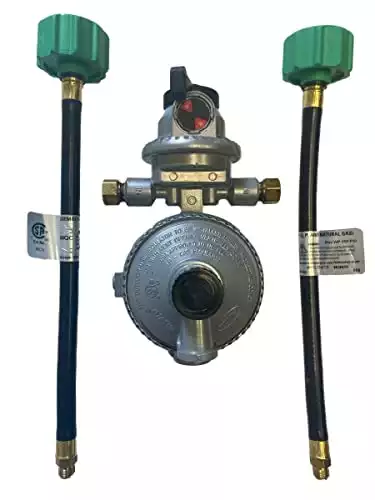
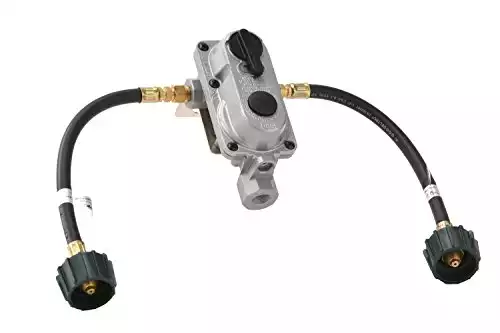
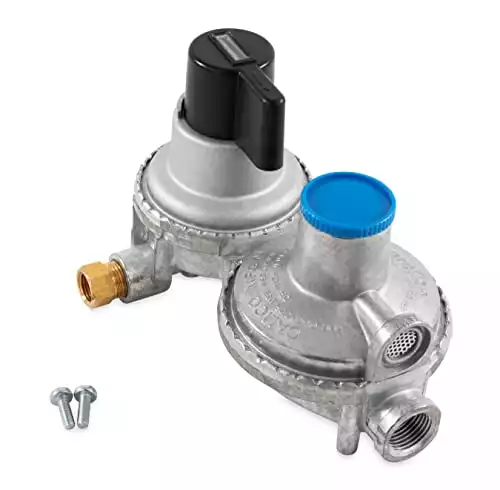
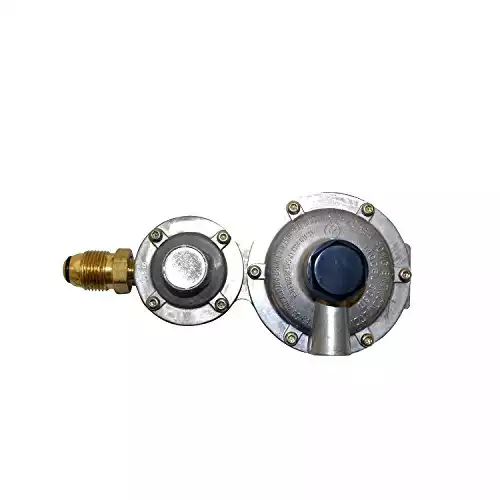
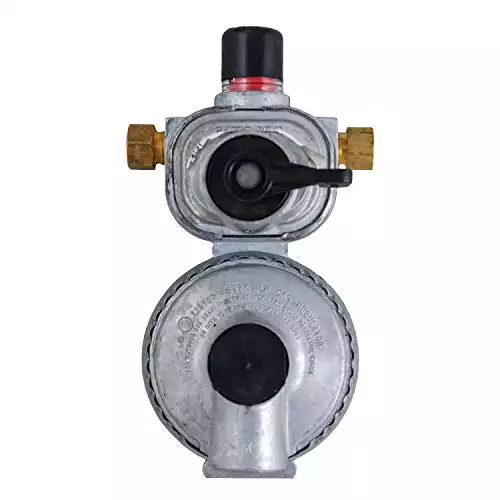
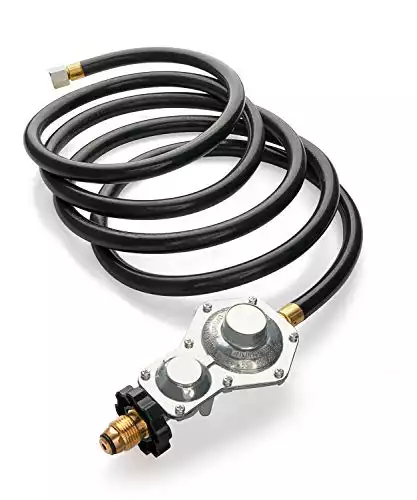
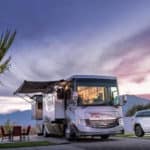

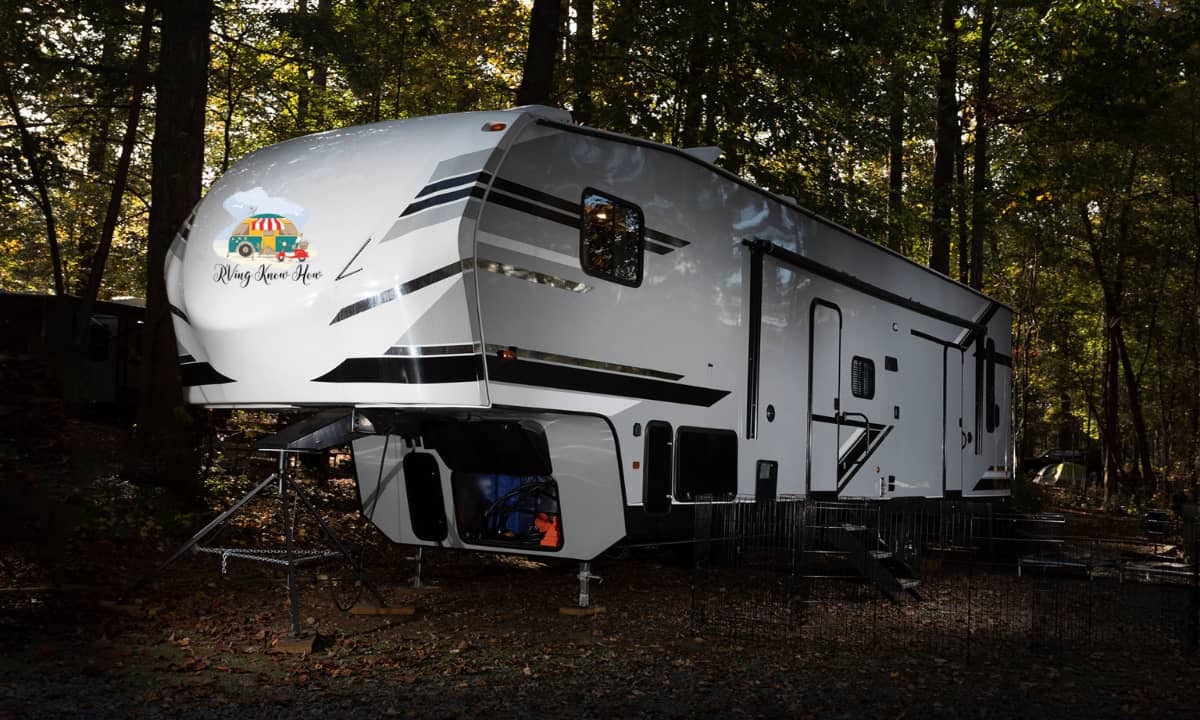
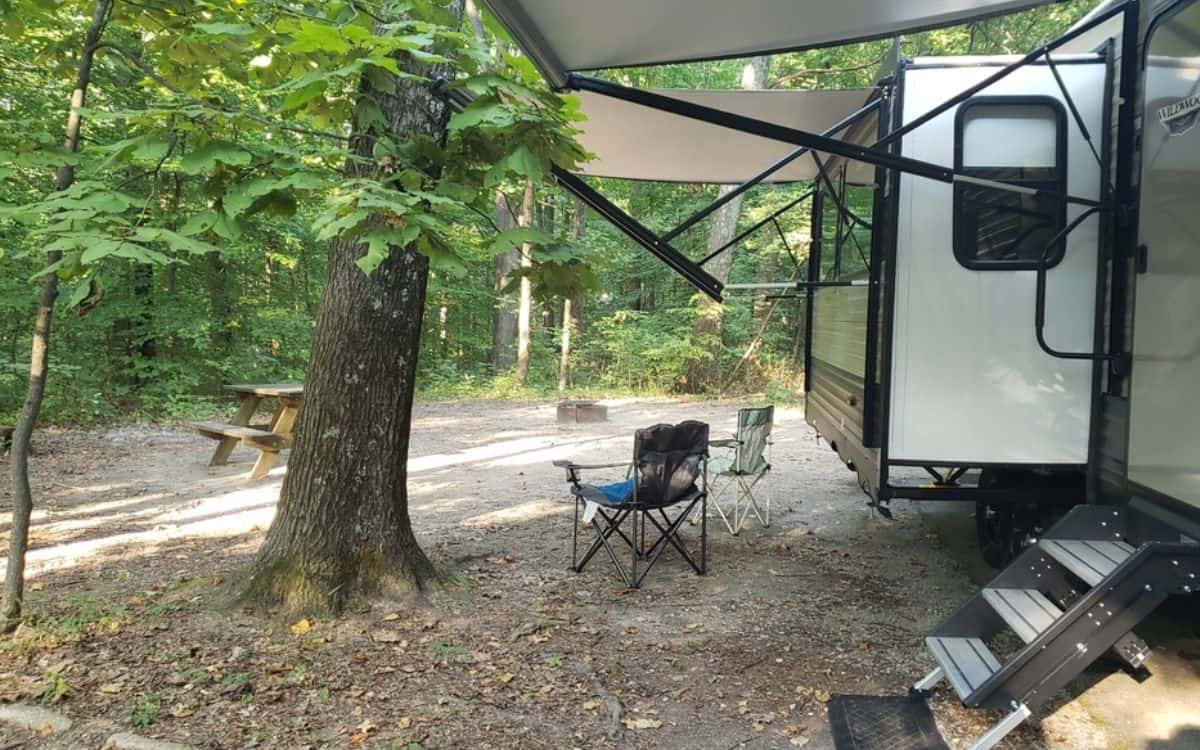
![The 6 Best Portable Air Conditioners For RVs In [currentyear] 12 Best Portable Air Conditioners For RV](https://www.rvingknowhow.com/wp-content/uploads/2020/06/Best-Portable-Air-Conditioners-For-RV.jpg)